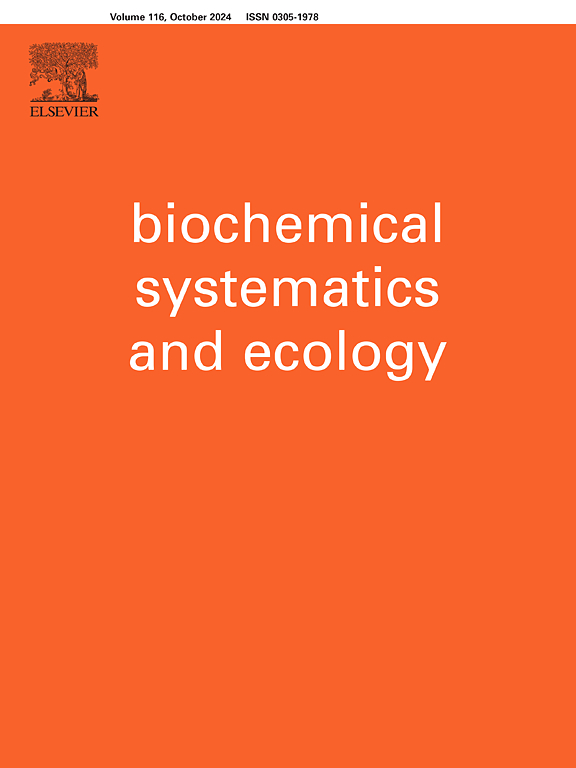濒危药用植物厚朴的新木质素及其化学分类意义
IF 2
4区 生物学
Q4 BIOCHEMISTRY & MOLECULAR BIOLOGY
引用次数: 0
摘要
对濒危植物厚朴(一种中药和保健食品,“厚朴”)的树枝和叶子进行植物化学调查,分离出12种新木质素,包括一种以前未描述的化合物(1),五种已知的氧新木质素(2 - 4,11和12)和六种联苯型新木质素(5-10)。这些化合物的结构通过hresms和1D/2D NMR进行了分析,并与文献数据进行了比较。化合物1具有两个倒卵形衍生的基团,通过C6-C2″键直接连接到芳香环上。Garrettilignan A(2)为首次从厚朴中分离得到。此外,还讨论了白玉兰中分离的新木质素属植物的化学分类。本文章由计算机程序翻译,如有差异,请以英文原文为准。

Neolignans from the endangered medicinal plant Magnolia officinalis and their chemotaxonomic significance
A phytochemical investigation of the twigs and leaves of the endangered plant Magnolia officinalis (a traditional Chinese medicine and health food, “Houpo”) led to the isolation of 12 neolignans, comprising one previously undescribed compound (1), five known oxyneolignans (2–4, 11, and 12), and six biphenyl-type neolignans (5–10). The structures of these compounds were elucidated using HRESIMS and 1D/2D NMR spectroscopy and corroborated by comparison with literature data. Compound 1 features two obovatol-derived moieties linked directly to an aromatic ring through a C6–C2″ bond. Garrettilignan A (2) was isolated from the Magnolia officinalis for the first time. Additionally, the chemical classification of the isolated neolignans within Magnolia is discussed.
求助全文
通过发布文献求助,成功后即可免费获取论文全文。
去求助
来源期刊

Biochemical Systematics and Ecology
生物-进化生物学
CiteScore
3.00
自引率
12.50%
发文量
147
审稿时长
43 days
期刊介绍:
Biochemical Systematics and Ecology is devoted to the publication of original papers and reviews, both submitted and invited, in two subject areas: I) the application of biochemistry to problems relating to systematic biology of organisms (biochemical systematics); II) the role of biochemistry in interactions between organisms or between an organism and its environment (biochemical ecology).
In the Biochemical Systematics subject area, comparative studies of the distribution of (secondary) metabolites within a wider taxon (e.g. genus or family) are welcome. Comparative studies, encompassing multiple accessions of each of the taxa within their distribution are particularly encouraged. Welcome are also studies combining classical chemosystematic studies (such as comparative HPLC-MS or GC-MS investigations) with (macro-) molecular phylogenetic studies. Studies that involve the comparative use of compounds to help differentiate among species such as adulterants or substitutes that illustrate the applied use of chemosystematics are welcome. In contrast, studies solely employing macromolecular phylogenetic techniques (gene sequences, RAPD studies etc.) will be considered out of scope. Discouraged are manuscripts that report known or new compounds from a single source taxon without addressing a systematic hypothesis. Also considered out of scope are studies using outdated and hard to reproduce macromolecular techniques such as RAPDs in combination with standard chemosystematic techniques such as GC-FID and GC-MS.
 求助内容:
求助内容: 应助结果提醒方式:
应助结果提醒方式:


